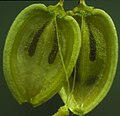Fissure fruit
A fissure fruit is a sub-form of the decay fruit . It disintegrates to maturity by splitting exclusively real partitions into two or more partial fruits (mericarpies). A stalk-like fruit holder ( carpophor ) sometimes remains between them . In contrast, when ripe, the broken fruit breaks along false partitions into several solitary partial fruits, limbs.
Important plant families with fissure fruits in Central Europe are the maple family , most of the mallow family , the cranesbill family and the umbelliferae . In these, the split fruits are also known as double achenes (cremocarp).
Special forms are the Regma (Coccarium) where the partial fruits jump up individually ( Castor , Geranium and Hura ) and the Carcerulus, where the individual partial fruits do not open and are detached as a whole ( Marshmallow , Abutilon and Mallow plants) the solitary partial fruits are called Cocci (cocci) called. As well as the multiple wing nut (samara) which divides into the individual winged wing nuts.
Fissure fruit, Doppelachäne on a carpophor of Heracleum sphondylium
Cacerulus from Abutilon theophrasti
Regma by Hura crepitans , you can see the individual, still unopened cocci, which later burst open with a loud bang
Carcerulus of Althaea cannabina with the cocci
literature
- Richard W. Spjut: A Systematic Treatment of Fruit Types , The World Botanical Associates Web Page, accessed April 9, 2008.
- Wolfgang Stuppy: Glossary of Seed and Fruit Morphological Terms - Kew Gardens. 2004, online (PDF).




